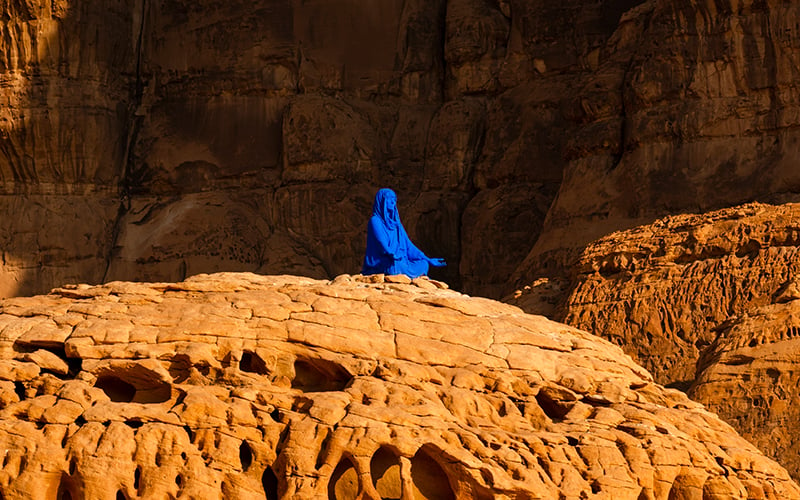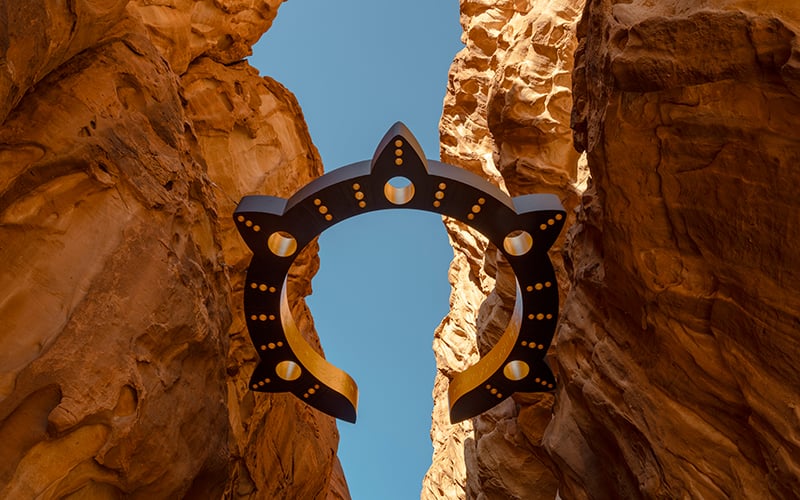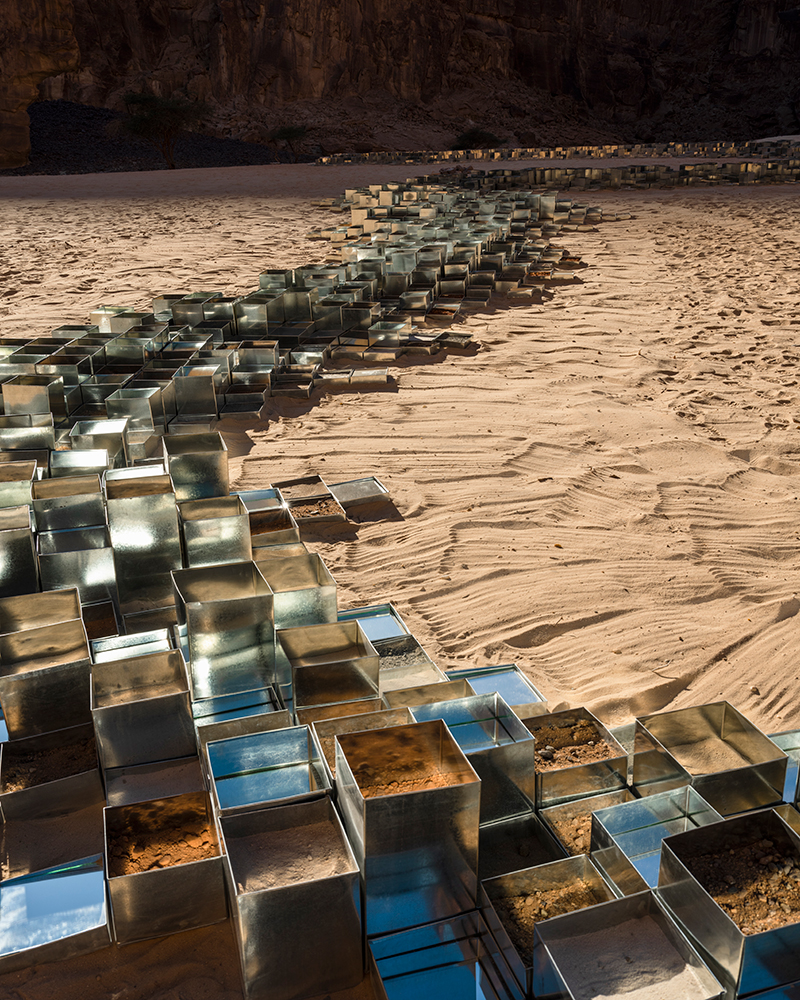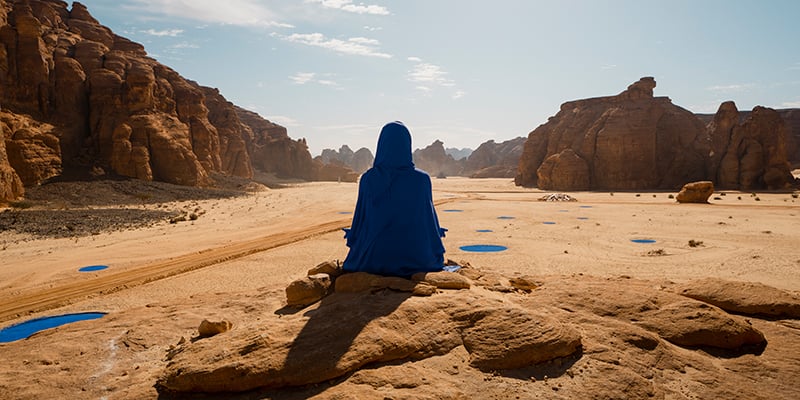On until March 7
For the first time, contemporary art exhibition Desert X has travelled from Coachella Valley to AlUla’s golden canyon in Saudi Arabia. The event shines a light on regional and international artists for a cross- cultural exploration of desert culture and it runs until March 7. We meet four female artists taking part in the groundbreaking cultural event in The Kingdom.
Who: Lita Albuquerque, based in Santa Monica
What: “NAJMA”

How did growing up in Tunisia inspire you and influence your artistic practice?
Growing up in Tunisia, in a Catholic Convent in Carthage overlooking the Carthagenian ruins and the Mediterranean gave me a sense of history rooted in the earth itself, and a sense of place rooted in colour and the natural elements like the wind and light. It also gave me a sense of ritual as we would pray in the Catholic chapel in the convent every sunrise and sunset, and hear the sound of prayers sung from the Mosques at 5:20 in the morning and 5:20 in the evening daily. There was a sense of sacredness in both cultures that was rhythmic and followed the natural pattern of the Earth rotating around the sun. Everything about being there influenced my artistic practice: the constant movement of the wind and the people; the colours red, blue and gold found both in religious Christian icons and in Islamic art. The Islamic art found in the calligraphy and architecture all around me. The sound of constant music like Oum Khalsum mixed in with the wind coming in from the beach. The sense of poetry; the connection to the Earth, to the sand, to the rocks and to the stars. Leaving Tunisia at a young age also influenced my practice, it made me question identity, and who we are in relation to location and placement on the planet and in the universe.
What is your connection to the colour cobalt blue?
Can you tell us about the choice of colour in your work? The colour blue was all around me growing up in Tunisia. From the blue of the Mediterranean that surrounded me as far as I could see, to the white and blue of the architecture in the town of Sidi Bou Said where I grew up, wanting to unite earth and sky, and proclaiming that my work is about the relationship of earth and sky through blue.
Where did the name of your piece for Desert X Alula, NAJMA come from?
The name “NAJMA” means ‘star’ in Arabic. The title also includes the phrase(She Placed One Thousand Suns On The Transparent Overlays Of Space). I wanted to be obvious that the sculpture who represents a 25th Century female Astronaut who comes to Earth to seed interstellar consciousness also came from a star, hence her name.
Can you tell us more about why you chose the participate in Desert X AlUla?
Art is a revolutionary tool and we must seize the moment! I will never forget witnessing one of those moments in 1956 in Tunisia. I was 10 years old and sitting in my mother’s verandah in the fishing village of La Goulette when the earth started trembling and I could hear what at first was a rumble which became a roar of “Haijah Bourguiba, Haijah Bourguiba. Haijah Bourguiba “ as tens of thousands of people had come all the way from the Sahara, from the south, from the centre of Tunisia from the north to greet their leader Bourguiba, who was to lead them to revolution and freedom arriving by ship in front of my mother’s house on that day in 1956, everyone unifying for a single cause of change. This is what I feel we have been privileged to be part of in the year 2020.
Who: Sherin Guirguis from Egypt, based in L.A
What: “Kholkhal Aliaa” installation

How do you describe your work?
My practice focus on the work of historically important women poets, craftspeople and others who have been marginalised, forgotten or erased over time.
Your last three exhibitions were about the Egyptian activist and poet Doria Shafik – what made you focus on her?
I focused on Doria’s work because it became apparent to me that very few people knew or remembered the important work she did throughout her life to support women’s rights in Egypt and internationally. Such an important activist whose work led to the suffrage of women in Egypt should be remembered by us all. Her lifelong dedication to women’s rights is an inspiration for me and I wanted to share that with the next generation of women. To remember and honour her work and be inspired by her once more.
Can you explain to me the process of translating history to abstract art?
I often use architecture and text to formally translate historical narratives into abstract paintings and sculptures. I research the significant sites specific to the history or person I’m researching and use elements from that site that in the work. Additionally, when appropriate, I use text that relates to that narrative which is then embedded in some of the “decorative” and “ornamental” elements of the architecture. This way the words and the site come together create an informal monument to that lost moment.
Who: Manal AlDowayan from Saudi Arabia, based in Dubai
What: “Now You See Me, Now You Don’t” installation

How do you represent women in your artwork?
I usually address the issues. For example, from the very beginning when I spoke about women in employment, it was because I was in a career and I did a collection called “I Am”, based on the arguments I had about my nature as a women and what jobs suit me as a women. If you read through all my artist statements on my website, you will notice that this conversation is very personal, but women do mirror what I feel as an individual.
Can you tell us briefly about the main focus of your artistic approach for people who are not familiar with your artwork?
I’m a multimedia artist that works in subjects that address invisibility and disappearance, and visibility and appearance. I am mostly described as a conceptual artist because my concepts remain the same, whilst my materials constantly change depending on the situation of the artwork.
What kind of challenges did you face when you first started photography?
I found it difficult to find my space in the public sphere, photographing in the street or public spaces was quite complicated as it was not a common thing. But I think those kinds of restrictions really helped me change my practise and evolve it, and let it become what it is today. I created a couple of collections done from a moving car, from rooftops of buildings which sort of addressed this exclusion from the public sphere by creating collections of images which defied the idea of the public space, by being there but not really being there.
Tell us about your most recent piece of work and what you are working on?
My most recent work I have done is for Desert X AlUla, “Now You See Me, Now You Don’t”, and I am currently working on a new commission in Japan which is yet to be announced.
Who: Zahrah Al Ghamdi, from Saudi Arabia, based in Jeddah
What: “Glimpses of the Past”

What is your main inspiration?
It’s important for me to smell the sand and feel it with my own hands, because those senses of touch and smell allow my work a synergy, and if I don’t get that synergy, I can’t work. The sand should smell natural, like the smell of rain on land, the smell that manifests like steam when it rains.
How did you evolve your artistic vision?
Growing up in the southwestern region of Saudi Arabia surrounded by traditional Aseeri architecture has played an integral role in my practice. I then moved to Jeddah where I completed my undergraduate’s degree in Islamic Arts from King Abdulaziz University. I also hold a Master’s Degree specialising in Contemporary Craft from Coventry University in England, where I also obtained my P.H.D in Design and Visual Art. I am now a faculty member of the Art and Design Department at Jeddah University.
Who influenced or influences you in terms of other artists?
I am influenced by lan art and artists such as Robert Smithson, Richard Long and Andy Goldsworthy.
What can you tell us about the young artist talents in Saudi Arabia and the Gulf?
The Kingdom of Saudi Arabia is currently experiencing a strong artistic revolution, by the emergence of many artists who have high capabilities of creative thinking. Also, the government, galleries and other art organisations have supported many artistic events, which helped encourage artists to participate in a burgeoning contemporary art scene. On the Gulf level, we find that there is a lot of collaboration between countries artistic communities, which has led to an increase in cultural and artistic interconnection.
Media: Supplied











